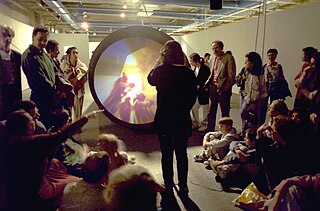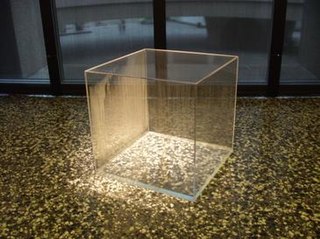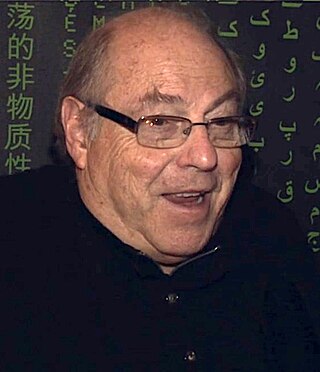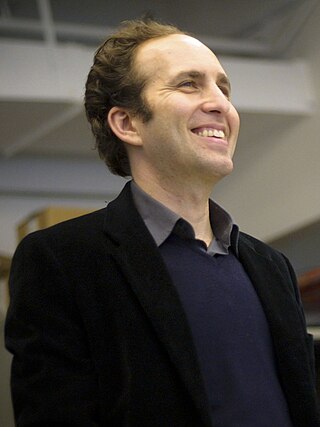Related Research Articles

Installation art is an artistic genre of three-dimensional works that are often site-specific and designed to transform the perception of a space. Generally, the term is applied to interior spaces, whereas exterior interventions are often called public art, land art or art intervention; however, the boundaries between these terms overlap.

Interactive art is a form of art that involves the spectator in a way that allows the art to achieve its purpose. Some interactive art installations achieve this by letting the observer walk through, over or around them; others ask the artist or the spectators to become part of the artwork in some way.

Generative art is post-conceptual art that has been created with the use of an autonomous system. An autonomous system in this context is generally one that is non-human and can independently determine features of an artwork that would otherwise require decisions made directly by the artist. In some cases the human creator may claim that the generative system represents their own artistic idea, and in others that the system takes on the role of the creator.

Roy Ascott FRSA is a British artist, who works with cybernetics and telematics on an art he calls technoetics by focusing on the impact of digital and telecommunications networks on consciousness. Since the 1960s, Ascott has been a practitioner of interactive computer art, electronic art, cybernetic art and telematic art.
Simon Graeme Penny is an Australian artist, theorist, curator and teacher in the fields of digital cultural practices, embodied interaction and interactive art.

Scott Snibbe is an interactive media artist, author, entrepreneur, and meditation instructor who hosts the Skeptic's Path to Enlightenment meditation podcast. His first book, How to Train a Happy Mind, was released in 2024. Snibbe has collaborated with other artists and musicians, including Björk on her interactive “app album” Björk: Biophilia that was acquired by New York's MoMA as the first downloadable app in the museum's collection. Between 2000 and 2013 he founded several companies, including Eyegroove, which was acquired by Facebook in 2016. Early in his career, Snibbe was one of the developers of After Effects.

Fred Forest is a French new media artist making use of video, photography, the printed press, mail, radio, television, telephone, telematics, and the internet in a wide range of installations, performances, and public interventions that explore both the ramifications and potential of media space. He was a cofounder of both the Sociological Art Collective (1974) and the Aesthetics of Communication movement (1983).

Joachim Sauter was a German media artist, designer and technology entrepreneur. He was appointed Professor for New Media Art and Design at the Universität der Künste Berlin, UdK in 1991, and in 1993 he created Terravision, before pursuing a lawsuit against Google for infringing the patent. He became an adjunct professor at UCLA, Los Angeles in 2001.

Sonya Rapoport was an American conceptual, feminist, and New media artist. She began her career as a painter, and later became best known for computer-mediated interactive installations and participatory web-based artworks.
Pietro Grossi was an Italian composer pioneer of computer music, visual artist and hacker ahead of his time. He began experimenting with electronic techniques in Italy in the early sixties.

Maurizio Bolognini is a post-conceptual media artist. His installations are mainly concerned with the aesthetics of machines, and are based on the minimal and abstract activation of technological processes that are beyond the artist's control, at the intersection of generative art, public art and e-democracy.

New media art includes artworks designed and produced by means of electronic media technologies. It comprises virtual art, computer graphics, computer animation, digital art, interactive art, sound art, Internet art, video games, robotics, 3D printing, immersive installation and cyborg art. The term defines itself by the thereby created artwork, which differentiates itself from that deriving from conventional visual arts such as architecture, painting or sculpture.
Piero Gilardi was a visual artist. Born in Italy from a Swiss family, he studied at the Liceo Artistico in Turin. In an interview with LeGrace G. Benson, Gilardi stated that his personal encounter with artist Michelangelo Pistoletto and others helped him in the development of his own artwork. While trying to comprehend the cybernetic idea of feedback and the scientific rationale behind man's mental synthesis, his perspective on reality changed; he then focused on the fluxus and relationship of things around him.
Olivier Auber is a French independent artist and researcher. He is best known for his project "Poietic Generator" and for having introduced the concept of "Digital Perspective" in the fields of network theory, art, and digital humanities.

Ars Electronica Linz GmbH is an Austrian cultural, educational and scientific institute active in the field of new media art, founded in Linz in 1979. It is based at the Ars Electronica Center (AEC), which houses the Museum of the Future, in the city of Linz. Ars Electronica's activities focus on the interlinkages between art, technology and society. It runs an annual festival, and manages a multidisciplinary media arts R&D facility known as the Futurelab. It also confers the Prix Ars Electronica awards.

Ernest Edmonds is a British artist, a pioneer in the field of computer art and its variants, algorithmic art, generative art, interactive art, from the late 1960s to the present. His work is represented in the Victoria and Albert Museum, as part of the National Archive of Computer-Based Art and Design.
Giuseppe La Spada artist, director and photographer inspired by nature, poetry and sound.

Franz Fischnaller is a new media artist and transdisciplinary researcher. He is recognized for the creation of his digital, virtual reality and interactive art installations works across the fields of art, technology, humanities and cultural heritage.
Edwin van der Heide is a Dutch sound artist and composer known for his immersive installations and performances, currently living in Rotterdam.
References
- ↑ "Mario Canali". studiocanali.com. Retrieved 3 January 2011.
- ↑ Godal, Vicki (22 January 2010). "Italian artist Mario Canali comes to Los Angeles". Forth Magazine. Retrieved 3 January 2011.